There is a proposal from the BJP camp that they would resort to a proportion-based increase in the number of Lok Sabha seats for individual states, based on what they now have.
On the face of it, this sounds like a fine argument that those demanding a 'freeze' now cannot oppose without reasons and justification, avers N Sathiya Moorthy.

Barring a few nuggets and issues that were not addressed, the inaugural meeting of the Joint Action Committee (JAC) of 23 parties on delimitation, hosted by Tamil Nadu Chief minister M K Stalin on March 22, 2025, ran on predictable lines.
There was the unanimous resolution urging the Bharatiya Janata Party-ruled Centre to put off delimitation by another 25 years.
Though the rationale was not explained, it was a sound suggestion as the new deadline would fall five years after the formulation of the next edition of the National Population Policy, due in 2045, and all stake-holders would have a fair idea of what's in store for them to come up with options, suggestions and decisions.
Under such circumstances, it does not matter that the JAC also proposed to retain the 1971 Census figures for effecting delimitation.
Either the suggestion is redundant or self-contradictory. There's nothing in between, for the JAC's two proposals to go together in the same resolution.
The JAC speeches were all on predictable lines. Talking to newsmen outside the conference venue, Telangana's Bharatiya Rashtra Samithi Working President K T Rama Rao made two interesting points.
His first suggestion was to link the increased number of Lok Sabha seats not to population figures, but growth figures instead.
Rama Rao pointed out how the southern states together accounted for only 19 per cent of the nation's population but contributed 36 per cent earnings.
Other speakers reiterated their known positions, that their states were all being 'penalised' for growth and the consequent success in stabilising their population.
But Rama Rao came up with a suggestion to reward them, and also linked it to delimitation. While his suggestion can be discussed, it's as much debatable, too.
Rama Rao's second proposal was for effecting population-based increase in the number of assembly seats in individual states even while maintaining the status quo on the number of Lok Sabha seats for another 25 years.
It sounds logical, but only up to a point.
The number of Rajya Sabha seats for each state, too, is linked to its population.
So, while freezing the number of Lok Sabha seats, care should also be taken to freeze the number of Rajya Sabha seats, including state-wise figures.

Even without it, there will be a need to freeze the number of Rajya Sabha seats if the Lok Sabha seat number is to be frozen for 10, 15 or 25 years or whatever.
Even without it, there will be the problem of number of members 'nominated' to the Rajya Sabha, by the President of India, as and when delimitation covers the Lok Sabha.
In tune with the number of Lok Sabha seats in each state, there would be a corresponding increase in the number of Rajya Sabha seats -- both based on the new population figures.
For the same reason, states like Tamil Nadu that stand to lose a number of Lok Sabha seats if delimitation is carried out before NPP-2045 and is also based on population, will also lose on the Rajya Sabha seat-count, precisely for the same reason.
Then the question may arise on increasing the number of 'nominated' seats. At present it is 12, and owes to the socio-cultural milieu as existed at the turn of Independence.
Today, with vast and varying diversification of the socio-economic structure and greater focus on subjects like environment, and also science and technology, for instance, there may be a need to increase that number.
Yet, that number, if increased, should not be too huge to make it a larger constituency of the party in power.
The purpose of parliamentary democracy would be served if and only if the final decision derives from a widespread national discourse even on this limited subject.

Overall, the outcome of the Chennai consultations is not what it produced but in the decision of the participating political parties that they are here to stay and together, on this one score.
It is unclear if Telangana's Congress Chief Minister Revanth Reddy had the party high command's clearance, but his announcement that they would have the next JAC meeting in Hyderabad is an endorsement that the latter is alive to the needs of the South.
Interestingly, Odisha's Biju Janata Dal leader and five-time chief minister Naveen Patnaik addressed the Chennai session through video-conferencing, and endorsed the outcome.
As is known, Patnaik had kept aloof from all presumably 'anti-BJP conclaves' of the kind when he was in power, but the rout his BJD faced in the Lok Sabha and assembly elections last year, that too at the hands of the one-time BJP 'friend' (?) has forced him to scramble for friends from other regional parties.
Yet, it remains to be seen if Patnaik or even Kerala's CPI-M chief minister Pinarayi Vijayan will attend the Hyderabad conclave.
More than in Odisha, it's in Kerala that the Congress-UDF is the main electoral rival still of the ruling CPI-M-led LDF.
There can be no question of Revanth Reddy not inviting either of them, but it is not easy especially for his Kerala counterpart to attend it and face cadre-wrath back home.
Already, the delimitation talk and conclave from down south should have embarrassed the DMK's north Indian allies.
If Patnaik and Rama Rao could participate when they are not in power, questions will be asked as to why the Samajwadi Party from Uttar Pradesh and the Rashtriya Janata Dal from Bihar, both the DMK's partners in the INDIA combine, stayed away.
The answer is equally simple, as they are the 'target states' when the discourse is on population-centred delimitation.
The same argument can/cannot apply to West Bengal's Mamata Banerjee and her ruling Trinamool Congress.
Was it because West Bengal may stand to gain in a population-centred delimitation, or because Stalin chose to invite also chief ministers from the CPI-M and Congress, or because through this one issue, after NEET, NEP and 'Hindi imposition' Stalin has hijacked her claims to become the possible central force in any 'third front' of the future?

There is some truth in Union Home Minister Amit Shah's early offer that Tamil Nadu would not stand to lose any Lok Sabha seats in the event of a population-based delimitation.
There is also a proposal from the BJP camp that they would resort to a proportion-based increase in the number of Lok Sabha seats for individual states, based on what they now have.
On the face of it, this sounds like a fine argument that those demanding a 'freeze' now cannot oppose without reasons and justification.
However, this would negate the very purpose of the nation waiting from 2000 (when the BJP's Atal Bihari Vajpayee was prime minister) to this day, hoping for a stabilisation in population-growth across the country.
Then and now, the expectation and goal were only for achieving 'population stabilisation' only by NPP-2045.
Any delimitation with or without reference to population any time soon could prove to be a disincentive for 'population stabilisation' across the country, if it's one reason in this regard.
Already, Tamil Nadu's Stalin is on record, urging people in his state to have more children, as fewer heads in the state than earlier has proved to be a 'disincentive' in terms of parliamentary representation.
Of course, he was not serious about it, nor are the state's people going to take it seriously.
The irony is that even before Stalin, Andhra Pradesh CM N Chandrababu Naidu, an NDA member, had made such an appeal to people in his state.
Of course, the Naidu government promises to incentivise larger families to offset an ageing population -- which incidentally is also going to be a national problem, in the decades to come.
Such policies to address the issue of an ageing population is going to be a standalone affair when it hits the nation in its face, and there is a need for evolving a national policy on the same, even without having to wait for NPP-2045.
Rather, that policy should derive from population growth, 'ageing anomalies' and the like, which will become known only after the decennial Census, which has already been delayed beyond the nominal 2021 -- yet, that issue would not have any direct correlation to delimitation, after all.
N Sathiya Moorthy, veteran journalist and author, is a Chennai-based policy analyst and political commentator.
Feature Presentation: Aslam Hunani/Rediff.com
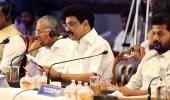

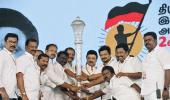
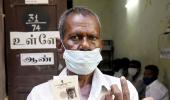




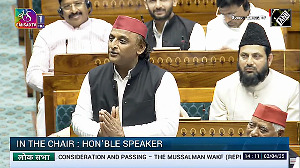
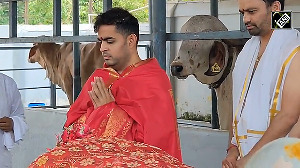

 © 2025
© 2025